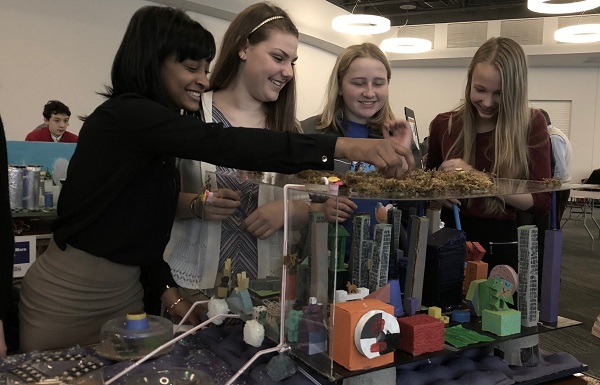
How will we live in the future? These kids offer cool solutions for cities ahead of their time.
Photos by Stephanie Hacke.
Kids from Propel East envision a way for coastal cities to survive when waters start to rise from global warming.
The plan: Live underwater.
“Global warming is a major factor on the earth and it’s irreversible, so we thought we may as well start living in the water,” says Caleb Lohr, 12.
Their idea is to build a dome around Aquacivis, a city in the year 2130 that is powered by algae.
“When algae goes to photosynthesis, it gives off a minor electric current,” says Juliana Connelly, 13. “So, by harnessing those currents, it allows for a renewable and environmentally friendly place to live.”
To that end, the team envisioned SAM, a Self-Automated Algae Machine, which will collect algae from the outside of the dome to make it quicker, easier and safer to collect the energy.
This forward-thinking group is one of 19 middle school teams who gathered at Carnegie Science Center for the regional DiscoverE’s Future City Competition. This year’s theme, Powering the Future, challenged kids to imagine and design innovative power grids for their future cities that can withstand and quickly recover from the impacts of a natural disaster.
Through the process, kids learn about engineering and why science and math are relevant to their lives.
The first-place team, Fort Couch Middle School, heads to the Future City Competition National Finals in Washington, D.C., during Engineers Week in February. St. Edmund’s Academy took second place, followed by West Mifflin Area School District at third, St. Bede School at fourth, and Marion Center Junior/Senior Highh School at fifth place.
Teams have been working for months researching how cities work, the important issues a city faces and how power grids operate, says Liz Whitewolf, director of science and education at the Carnegie Science Center, which partnered with Future City for the regional competition.
“They’re learning about engineering, power and power sources, and maybe they’re learning about alternative energy, maybe they’re learning about electricity,” she says. “It’s really up to them to define the challenge and make it their own.”
Teams turn in documentation of their findings and keep to a schedule, just like professional engineers. Their $100 budget forces them to be thrifty and learn how to re-use recycled materials.

The team of students from West Mifflin Area Middle School found the solution for tornadoes and flash flooding for their city, located near Topeka, Kansas. Their city, Imperium Civitas, is set in the year 2023.
Their plan includes houses built on hydraulics that move underground during a natural disaster. Solar panels provide electricity for a week, with a backup battery, if needed, says Flynn McCracken, 13.
The city’s roads are made of permeable concrete that allows water to flow to an underground system, where it is caught and filtered.
“We rely on clean energy,” says Angkith Khatiwada, 13. “All of our cars are electric, so our citizens don’t have to live in a polluted area.”
The team at St. Bede School saw a way to embrace the floods in their city, called Jala Kamala, by taking a cue from the lotus flower.
“When water hits the lotus flower, it beads up and rolls off, taking any diseases with it,” says Bridget Shaver, 13.
The team created “lotus skin,” to apply to the town’s buildings, using a substance that coasts nonstick cooking pans. The town runs on hydro turbines and wind turbines shaped like the lotus flower.
STEM lessons aside, working together brought a whole other level of knowledge and experience.
“Teamwork is everything,” says Nya White, 14. “If you don’t have teamwork, you have no idea what’s happening.”